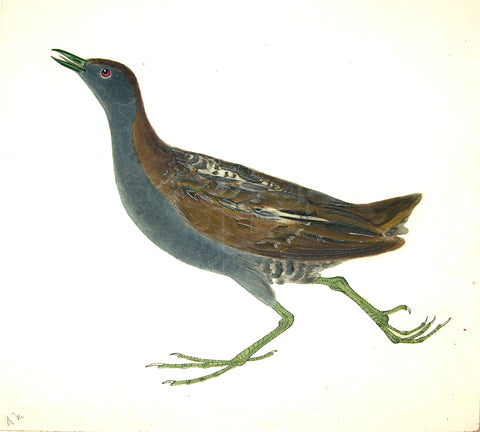
ROBERT MITFORD (BRITISH, 1781-1870), “Little Crake”
ROBERT MITFORD (BRITISH, 1781-1870)
“Little Crake”
Preparatory work for Prideaux John Selby’s Plate 30 of Illustrations of British Ornithology
Watercolor, gouache, grey and brown washes, pen and black ink on paper
Initialed lower left: R.M.
Paper size: 8 1/4 x 7 1/2 in.
PLATE 30. Fig. 4. Represents it of the natural size, from the above mentioned specimen in the possession of the Rev. Mr GISBORNE. General Bill five-eighths of an inch long, slender, and of a fine sap-green colour. Irides crimson-red. Throat, sides of the head, and neck, breast, and abdomen, deep bluish-bird, grey. Crown of the head, back part of the neck, and upper parts of the body, deep oil-green, tinged with brown. Down the mesial line of the back is a broad streak or patch, composed of feathers marbled with black and white. The scapulars have a longitudinal bar of white, encircled with black, near the margins of the feathers. Smaller coverts plain oil-green, the greater ones having white tips, surrounded by a line of black. Vent and under tail-coverts blackish-grey, transversely barred with white. Quills and tail hair-brown, tinged with oil-green. Legs and toes sap-green. Tarsus one inch in length. Middle toe, with its claw, one inch and a half long. Wing-spine small and short.
In the female, the eyebrows and cheeks are pale grey. Female. The throat greyish- white. Neck and breast of a paler grey, slightly tinged with yellowish-brown. The dark mesial line on the back having fewer white spots.
The young have few or no distinct white spots upon the Young. upper parts of the body ; and the fore part of the neck, the breast, and belly, are of a yellowish- white. The flanks, vent, and under tail-coverts brown, barred with pale yellowish-brown.”
Considered by many as the English equivalent of Audubon, Prideaux John Selby created some of the most memorable bird images of the nineteenth-century. His contributions to British ornithology were rivaled only by those of John Gould. Yet, his pictures were larger and less purely scientific, exhibiting Selby’s distinctive and charming style. A sense of Selby’s enthusiasm for his subjects is nowhere more palpable than in his engaging original watercolors. Selby executed these delightful images as preparatory models for his landmark printed series, Illustrations of British Ornithology. While the artist’s engraved work is highly desirable to collectors, Selby’s original watercolors rarely become available. This selection of watercolors, moreover, comprises several of his masterpieces. The distinctive birds are depicted in profile, their forms delineated by softly modulated tones of black and gray wash. The setting, if present, is lightly but skillfully painted to not distract from the birds themselves. The skill and delicacy of Selby’s touch, his keen powers of observation, and his artistic sensitivity are conveyed here in a way they are not in his printed work. Several of the drawings are by Selby’s brother-in-law, Robert Mitford, but signed in Selby’s hand.
Born in Northumberland and educated at University College, Oxford, Selby was a landowner and squire with ample time to devote to studying the plant and animal life at his country estate, Twizell House. As a boy, he had studied the habits of local birds, drawn them, and learned how to preserve and set up specimens. Later, Selby became an active member of several British natural history societies and contributed many articles to their journals. Although Selby was interested in botany and produced a History of British Trees in 1842, he is best known for his Illustrations of British Ornithology. Selby’s work was the first attempt to create a set of life-sized illustrations of British birds, remarkable for their naturalism and the delicacy of their execution. The British Ornithology was issued in nineteen parts over thirteen years; the book consisted of 89 plates of land birds and 129 plates of water birds, engraved by William Lizars of Edinburgh, the printer who engraved the first ten plates of Audubon’s Birds of America.
With their rich detail and tonal range, these exquisite watercolors are beautiful works by one of the foremost British bird painters. Furthermore, they represent a singular opportunity to obtain a unique piece of the highest quality by this luminary artist, from an era in British ornithological art that remains unparalleled.
or by email at loricohen@aradergalleries.
We Also Recommend





